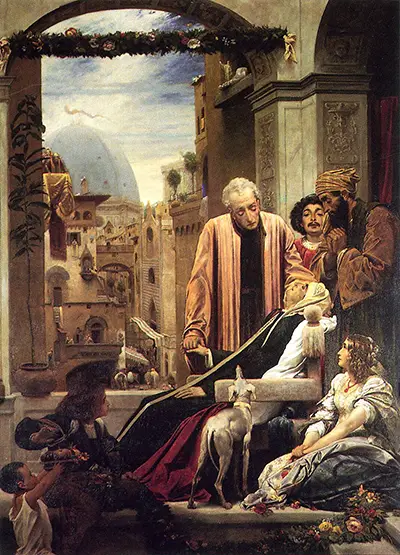 Buy Art Prints Now
Buy Art Prints Nowfrom Amazon
* As an Amazon Associate, and partner with Google Adsense and Ezoic, I earn from qualifying purchases.
The painter, Frederic Leighton, was keen on Brunelleschi's death by following the proceedings as they happened in a certain building in Florence. Filippo Brunelleschi was instrumental in the southern renaissance, a great figure in the architectural and civil engineering spheres.
His work on the development of the first geometrically correct perspective projection that was intended to be used in 2D drawings and paintings has always remained one of his greatest achievements. In the foreground of the painting, there is a building located in Florence, whose view reveals the view of the dome of the cathedral. Brunelleschi is shown a semi-recumbent in extremis in a chair accompanied by an array of buildings in the painting’s background that are seemingly defy the correctness in the projection of perspective.
However, a closer look at these buildings reveal a more complex use of perspective that brings out a contrasting effect the flatness of the dying man on the painting. The painter did this painting while in Italy, utilising the element of perspective to bring out Brunelleschi’s perspective when used in a visual manner.
Frederic Leighton was keen to use an impressive amount of intensity in the painting that clearly brought out its originality. This painting was a clear depiction of how his work slowly grew from naturalism, aestheticism, and romanticism techniques and gradually into neoclassicism. This later inspired him into getting into academism style of art, which inspired him to come up with this painting. This enabled him bring out a dreamy-like vividness in portraying the dying state of Brunelleschi.
There is a clear emphasis on the human bodies in the painting especially on the male subjects in it, which was a smart way of using symbolism. This master piece was created on canvas, the vividness of the objects in the painting were brought to life by the oil technique of painting he employed in 1853. Frederic as an artist was a source of inspiration and influence to many artists and painting styles over the years. However, not only was he a great inspiration to other artists, but he was also influenced by some few great artists in their own stature.
Some of the artists he was influenced by were the likes of Eugène Delacroix, Paolo Veronese, Jean-Baptiste-Camille Corot, Jean-Auguste-Dominique Ingres and Michelangelo. These are all great names in history of paintings. Nevertheless, he also derived his inspiration from domestic artists such as the likes of John William Waterhouse, Dante Gabriel Rossetti, Edward Burne-Jones, Harry Bates and Edward Onslow-Ford. Some of the most renowned paintings done by Leighton included the Icarus and Daedalus (1869) and the Portrait of a Roman Lady (La Nanna) (1858).




